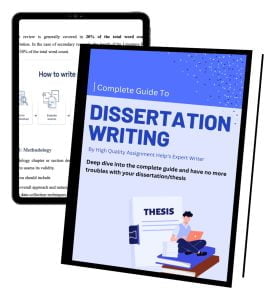The field of computer science is rapidly evolving, with new research being published every day. As a computer science student or researcher, it is essential to stay up-to-date with the latest advancements and discoveries. One effective way to achieve this is by conducting a comprehensive literature review. In this guide, we will walk you through the process of conducting a literature review in computer science, with the help of assignment writing help from planning and preparation to writing the review itself.
A literature review is a critical analysis and evaluation of existing research on a specific topic. It aims to identify and synthesize relevant information from various sources to provide a comprehensive understanding of the subject matter. In computer science, a literature review helps researchers identify research gaps, understand the state-of-the-art, and build upon existing knowledge.
Planning and Preparation
Before diving into the literature review process, it is crucial to plan and prepare adequately. Here are some key steps to consider:
Define the research question
Clearly define the research question or objective of your literature review. This will guide your search and help you stay focused on the relevant materials.
Determine the scope of the review
Decide the boundaries and scope of your review. Will you be focusing on a specific subfield of computer science? Will you include recent research or limit the review to a specific time period?
Identify relevant keywords and search terms
Compile a list of keywords and search terms that accurately represent your research question. This will help you conduct effective searches and retrieve relevant literature.
Searching for Literature
Now that you have a clear plan in place, it’s time to search for relevant literature. Here are some strategies to consider:
Utilizing academic databases
Academic databases such as IEEE Xplore, ACM Digital Library, and ScienceDirect are excellent resources for finding computer science research papers. Utilize advanced search options and filters to narrow down your search results.
Exploring digital libraries and repositories
Digital libraries and repositories like arXiv and Google Scholar offer access to a vast collection of preprints, conference papers, and technical reports. These platforms are particularly useful for finding the latest research.
Conducting systematic searches
Consider using systematic search methods such as the PICO framework (Population, Intervention, Comparison, Outcome) to structure your searches and ensure comprehensive coverage of the literature.
Evaluating and Selecting Sources
With numerous sources available, it is crucial to evaluate and select the most appropriate ones. Here’s what you should consider:
Assessing the credibility and relevance of sources
Evaluate the credibility and quality of the sources by considering factors such as peer review process, author affiliations, and publication reputation. Ensure that the selected sources align with your research question.
Identifying reputable journals and conferences
Identify reputable journals and conferences in the field of computer science. Papers published in well-established venues are more likely to contain high-quality and influential research.
Using citation analysis to find influential works
Perform citation analysis on relevant papers to identify highly cited works. These papers often serve as foundational or seminal works within the field.
Reading and Summarizing
Reading and summarizing the selected literature is a critical step in the literature review process. Follow these tips to make the most of your reading:
Skimming and scanning techniques
Use skimming and scanning techniques to quickly identify the main points, key findings, and methodology of each paper. This will help you determine its relevance to your research question.
Taking effective notes
Take concise and organized notes while reading each paper. Note down key arguments, methodologies, and results. This will aid in synthesizing information later on.
Organizing and categorizing information
Organize and categorize the information you have gathered based on themes, subtopics, or methodologies. This will help you identify patterns and connections between different studies.
Analyzing and Synthesizing
Analyzing and synthesizing the information you have collected is crucial to drawing meaningful conclusions from the literature. Consider the following:
Identifying common themes and trends
Look for common themes, ideas, and trends across the literature. Are there recurring topics or methodologies? Identifying these patterns will contribute to the overall coherence of your review.
Contrasting and comparing different studies
Analyze and compare the findings, methodologies, and arguments presented in different studies. Identify similarities, differences, and contradictions to provide a balanced perspective.
Detecting research gaps and unanswered questions
Identify research gaps or unanswered questions in the literature. This will help you position your research and contribute to the existing knowledge in the field.
Also if you want to know about “The Importance of Literature Review in Law: A Comprehensive Guide” just click on here.
Writing the Literature Review
Once you have analyzed and synthesized the literature, it’s time to write your literature review. Follow these steps to ensure a well-structured and comprehensive review:
Structuring the review (introduction, body, conclusion)
Organize your literature review into distinct sections, including an introduction that provides context and background, a body that presents the main findings and analysis, and a conclusion that summarizes the key takeaways.
Presenting a logical flow of ideas
Ensure a logical flow of ideas throughout your review. Present your arguments and analysis in a coherent manner, guiding the reader through the different sections smoothly.
Incorporating critical analysis and interpretation
Provide critical analysis and interpretation of the literature. Evaluate the strengths and weaknesses of each study and discuss their implications for your research question.
Editing and Proofreading
After writing the initial draft of your literature review, it is crucial to edit and proofread it thoroughly. Consider the following:
Reviewing for clarity and coherence
Review your literature review for clarity and coherence. Ensure that your arguments are well-articulated and that the overall structure of the review makes sense.
Checking for grammatical and spelling errors
Proofread your review for grammatical and spelling errors. Use grammar and spell-checking tools, and consider seeking feedback from peers or mentors.
Ensuring proper citation and referencing
Double-check your citations and references to ensure they are accurate and follow the required citation style (e.g., APA, MLA). Properly acknowledging the works of others is essential in academic writing.
Common Challenges and Tips
Conducting a literature review in computer science can be challenging. Here are some common challenges and tips to overcome them:
Dealing with information overload
With a vast amount of literature available, it is easy to feel overwhelmed. Set specific criteria for selecting sources, stay focused on your research question, and consider seeking guidance from experts.
Managing time effectively
Effective time management is crucial when conducting a literature review. Create a schedule, set deadlines, and allocate dedicated time for reading, analysis, and writing.
Seeking guidance from experts
If you encounter difficulties during the literature review process, don’t hesitate to seek guidance from experts in the field. Consult your advisor, professors, or experienced researchers for valuable insights and recommendations.
By implementing the tips provided in this article, you can now resolve the issue of helping me write a literature review. Researchers can ensure a thorough, insightful, and impactful literature review that forms a solid foundation for their future research endeavors.
Conclusion
In conclusion, conducting a literature review in computer science is an essential step for staying updated with the latest research, identifying research gaps, and building upon existing knowledge. By following the steps outlined in this guide, you can conduct a comprehensive literature review that adds value to your own research and contributes to the advancement of computer science.Also you can consider literature review writing help services like Assignment Unlocked, with our highly qualified experts you can achieve academic success.
Still thinking about help me write a literature review don’t worry! Assignment unlocked services often have quality assurance measures in place. This may involve proofreading, editing, and plagiarism checks to ensure that the final assignment is of high quality and original.






